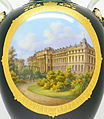Carl Daniel Freydanck

Carl Daniel Freydanck (born June 17, 1811 in Berlin ; † November 26, 1887 in Strausberg ) was a 19th century Berlin painter who exclusively painted vedutas for the Königliche Porzellan-Manufaktur Berlin (KPM).
Life
To person
Carl Daniel Freydanck was born in Berlin in 1811 as the son of Martin Freydanck, a worker at the Royal Porcelain Manufactory and his wife Friederike, née Schlösken. On June 30, 1811, he was baptized in the Trinity Church in Berlin. Freydanck's mother died on March 5, 1858 in Strausberg, the father on October 20, 1859.
On April 13, 1839 he married Henriette Charlotte Louise Wurstmacher (* December 16, 1818, † October 21, 1888) from Strausberg. The marriage remained childless.
education
At the age of 13, Carl Daniel began a six-year apprenticeship as a painter at the Königliche Porzellan-Manufaktur Berlin . During this time he attended the drawing school of Professor Carl Röthig in the Royal Botanical Garden in Berlin .
In 1830 he took part for the first time in the Berlin Academy Exhibition (No. 148) with a landscape in oil after Frédéric Frégevize . From January 1, 1831 he was employed in the underglaze painting department of the green painters.
In 1832, the director of the manufacture, Georg Frick, initiated training as an oil painter with the academy professor Otto Hermann Emil Völcker . At the beginning of 1837 he was transferred to the landscape painter and only painted sketches and oil paintings of vedute as models for the porcelain painters .
The pictures
Emergence
Freydanck's job at KPM was to make oil paintings of vedute , which were to serve as templates for the porcelain painters at KPM. From 1837 Freydanck made numerous sketches and oil paintings of castles and public buildings in Berlin and Potsdam .
In July 1845, Freydanck made a trip to Silesia in the Hirschberg Valley on behalf of the king to make sketches of Hohenzollern castles in Erdmannsdorf and Fischbach, as well as churches and views of the town, from which he then made oil paintings in the following years.
In the autumn of 1847 a trip to the Rhine province of Prussia followed, also on behalf of the king, to take in the castles of Koblenz , Stolzenfels and Brühl . This also created some views from the castles of the Rhine and surrounding landscapes.
Charlottenburg Palace , garden side, 1840
Schloss Sanssouci with terraces, 1843
Fischbach Castle in Silesia, 1846
Koblenz Castle on a porcelain vase after a painting by Freydanck, 1848
Highlights

Since the porcelain painters had to remain anonymous, Freydanck was completely unknown as an artist. His extraordinary and precise presentation of vedute and the high artistic quality of his commissioned work can only be attributed to him because the KPM archive has been preserved and was accessible to art historians. Freydanck only became known to the public as an artist with a few exhibitions by the Prussian Palaces and Gardens Foundation Berlin-Brandenburg since 1983. Freydanck painted two of his paintings himself on porcelain plates. There are the representations of the Friedrichswerder Church and the old coin . These two plates are an outstanding masterpiece of porcelain painting.
Whereabouts
All of Freydanck's works, including around 250 oil paintings, are in the KPM archive, which is now managed by the Prussian Palaces and Gardens Foundation Berlin-Brandenburg and is not accessible to the public. The pictures and sketches are unfortunately in a very bad condition. All pictures and sketches are small and have similar dimensions (about 36 × 28 cm) so that they fit into the optical transmission device ( episcope ) with which the KPM projected the pictures onto the porcelain to be painted in order to achieve a true-to-original painting. Almost all of Freydanck's paintings and sketches were executed on porcelain from KPM.
Late years
After the March Revolution in 1848 , Freydanck was dismissed from KPM, like many other employees. He then moved to Strausberg, Wilhelmstr. 5-6. There he worked as a gardener.
In 1846 and 1850 Freydanck took part in the Berlin Academy exhibition with a few works. From 1867 to 1869 Freydanck ran a photographic studio in Strausberg, Vor dem Landsberger Tore No. 270.
gallery
The Kronprinzenpalais (Berlin) on a porcelain plate after a painting by Freydanck, 1838
Long Bridge (Potsdam) , around 1838
Friedrichswerder Church in Berlin, 1839, porcelain plate 15.5 × 11.5 cm, Kunstgewerbemuseum Berlin , SMPK, inv. 11.25
Stolzenfels Castle on the Rhine, 1847/48
Web links
literature
- Carl Daniel Freydanck, a vedute painter at KPM. Nicolai, Berlin 1987, ISBN 3-87584-210-3 .
- Wolfgang Scheffler: Berlin in the porcelain picture of his manufactory. Hessling, Berlin 1963, DNB 454321716 , p. 37.
- Köllmann Jarchow: Berlin porcelain. Klinkhardt & Biermann, Munich 1987, ISBN 3-7814-0264-9 , Volume I, pp. 76, 82, 86.
- Derek E. Ostergard: Along the Royal Road. The Bard Graduate Center for Studies in the Decorative Arts, New York 1993, OCLC 30919410 .
Individual evidence
- ↑ Kunstgewerbemuseum Berlin , SMPK, Inv.Nr. 11.25 and 11.24
- ↑ Wolfgang Scheffler: Berlin in the porcelain picture of his manufactory. Hessling, Berlin 1963, p. 37.
- ^ Carl Daniel Freydanck, A vedute painter of the KPM. 1987, p. 201.
- ↑ No. 200, view of the monastery church in Lehnin, No. 201, the giant head seen from Erdmannsdorf, No. 177, landscape near Erdmannsdorf, No. 178, female portrait
- ^ Carl Daniel Freydanck, A vedute painter of the KPM. 1987, p. 58.
| personal data | |
|---|---|
| SURNAME | Freydanck, Carl Daniel |
| BRIEF DESCRIPTION | German painter |
| DATE OF BIRTH | June 17, 1811 |
| PLACE OF BIRTH | Berlin |
| DATE OF DEATH | November 26, 1887 |
| Place of death | Strausberg |







